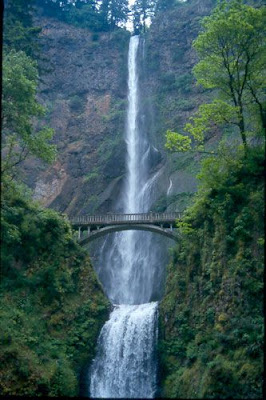This is the last of my three posts about my mid-March 2022 trip to the John Day Fossil Monument National Park in eastern Oregon. Located about 4 hours east of Portland, this unique national park has 3 units, each which very different experiences. I covered some of the logistics of how to get here in my first post, and the second post covered the 2 units of the Clarno Unit with its Palisades and the Sheep Rock Unit with the Blue Basin. This last post is only on visiting the Painted Hills, the most famous unit of the 3 and listed as one of the seven wonders of Oregon.
The Painted Hills Unit is located about 9 miles northwest of the town of Mitchell, Oregon, which makes it the closest base to visiting the unit. The stripes of red, tan, orange, yellow, streaks and dashes of black, all are a testament to the geological past representing changes in sediments over this region over 33 millions of years.
Plan part of your time visiting the Painted Hills as close to a golden hour (the 1-2 hours before sunset or after sunrise) as you can. The lighting between morning and late afternoon are different – I think in particular the early evening light is softer, so makes for great photos. Also, the main view you see at Painted Hills Overlook and Carroll Rim Trail are hills that you look east towards, so the sun will be behind the hills the first part of the day causing camera glare, and the colors of the valley between the hills in shadow at first. If you are visiting the Painted Hills after it rains, that’s a plus – the saturation of the clay soils will make the color of the hills intensify by sealing the surface to reflect light while also expanding the clay, and you will see more of the black manganese deposits streaks.
Spring is a great time of year as the temperatures will be more moderate – during our visit we were around mid 50-70 degrees Fahrenheit. There are five trails available at the Painted Hills – each short, but still carry plenty of water. Some vault toilets are available by a picnic area. There is no entrance fee to enter any of the units of the John Day Fossil National Monument, but note that only the Sheep Rock Unit offers a visitor’s center. When you enter the Painted Hills area, you will be on gravel roads. You may encounter wildlife crossing ranging from deer to cows along the way so drive carefully around the curves as you approach the park.
Most popular trails at Painted Hills
Painted Cove Trail is where you’ll want to head to first to get that iconic photo of the boardwalk and red hills. This is a .25 mile roundtrip loop on a level boardwalk so very accessible. Besides the boardwalk, the whole point of the boardwalk is that it lets you walk very close to the soils to see the different colors up close – otherwise your view of the colors will be from a distance. Needless to stay, stay on the boardwalk and trails as your footprints can damage and leave lasting imprints for years and the soils are very sensitive. You have to drive past the Painted Hills Overlook to reach here, but I prefer visiting Painted Cove as a first stop because it gives you a closeup view before your vista and panoramic views. Sun placement also doesn’t matter as much here.
You will see a few signs explaining some of the history and science behind the colors that paint the area. Each stripe of color soil is a different sedimentary layer of a different timeline geologically. The soil originated from volcanic ash that mixed and was compacted with other organic debris of plant, animal, and water and other minerals over time, and turning into fertile soils of forests and swamps. It also is a reflection of different climates over time. The area here, believe it or not, used to be like a tropical rainforest – but look at it now, part of the high desert. The red and yellow are from laterite soil, rich in iron, magnesium oxides, and aluminum. Like old metal, the hills are slowly oxidizing or rusting, staining the clay soils. The red colors are from when the climate was tropical so the iron-rich soil turned red with rust, while the yellow is from a time more cool and dry so no rusting/red. The stripes are thus reflecting the climate shifting between wet and dry and back again, with erosion then exposing the fossilized soils. The black soil is lignite that originates from manganese deposits from vegetation or dried up pools of water along the former floodplain. The grey coloring is mudstone, siltstone, and shale.
It’s quite the palette of color if you walk clockwise when you come to the boardwalk, so you can see as you go around the last part of the hill returning to the parking the contrast of colors of lavender, oranges, reds, of the earth, greens of trees and ground cover, and in the distance the blue waters of a reservoir.
Here at Painted Cove you can also encounter lavender-grey colored soil thanks to remnants of a rhyolitic lava, a stickier and thicker lava that flowed here and is a rock layer buried under the Painted Hills.
Next, Painted Hills Overlook is probably the most popular trail, which is a .5 mile roundtrip (.25 mile each way) and the first parking lot/trail you will see when you enter the park, about a mile in from the entrance. This mostly level, wheelchair accessible trail gives you a vista view of the hills, but is best seen after noon when the sun has gone past the hills so the hills are not shadowed and your camera won’t get sun glare. Still, don’t be surprised if your photos can’t capture the full magic – your eyes can capture more color then photos, so embed the views in your memory too.
There are three benches along the trail that punctuate some great views. Here’s the view from the start of the trail, and then the first bench a short distance in.
For the below view (first photo below), walk about halfway on the trail where you will find a second bench and a small grassy area showing a view which is beyond that initial hill (the yellow one with red stripes at the top and fuzzy top you see on the second photo to the right). Now you can gaze into this valley beyond between the small rounded and ridge of hills.
We stayed in Mitchell, so we came for sunset two days in a row. For this second set of photos, you can see how the moisture levels and lighting can have a different from the first night, and some of the shadow added in the valley as it was a more cloudy day. I also walked further to the end of the trail this time where you’ll find the final third bench, where the day before we turned around at the second bench.
As you walk towards the end of this trail to the last bench and turn around point, you get a slightly different view into the valley.
The other trails
These trails I separated out because less people take them. Many people may be taking a day trip, so with only a limited amount of time to stop, focus on those two previous trails. If you have more time, you should consider these however. The Carroll Rim Trail is the longest trail in the park trail at 1.6 miles roundtrip out and back. It’s only a short distance form the Painted Hills Overlook – in fact the overflow parking lot (because only a handful of cars can park right by the trail start) is only a short .2 mile walk away.
About 10 minutes in, you will encounter your first scenic bench with a view. The Carroll Rim Trail ascends over 400 feet in elevation gently, giving you a different view that include some of the smaller yellow hills you had passed on your way here and some of the redder parts of the northern side since Painted Hills Overlook is more focused on the southern side and the valley with black spots and streaks between the larger hills.
At one point it takes you around the back of a grassy hills before you circle back up. If you look back on this part, or simply on your way back on this out and back trail, you can see a view peeking down into the Painted Hills framed by the grassy green hills.
Continue on the trail until you get to your reward, a panoramic view of most of the park. None of this trail is very steep or strenuous, and the payoff of the view that you may have to yourself from above is worth the time. There are two benches up here so you can sit and enjoy the view before making your way back down.
We didn’t go on these last two trails, but perhaps you would like to? The Red Scar Knoll Trail mostly level trail leads to a hill of bright yellow and red clays. It’s a short 0.25 mile round trip and back that is the farthest of the Painted hills unit. Among multiple regular green ordinary hills, you find one hills that is a half and half pile of red and yellow clay soil aka Red Mountain. Finally, the The Leaf Hill Trail is 0.25 mile loop round trip that offers less visual appeal but more information with interpretative signs along the way providing history of the area and views of leaf fossils. The fossils here connect the Painted Hills unit to the overall John Day Fossils Bed National Monument and other two units in that there are rich with fossils that represent 50 million years of the Age of Mammals and Flowering Plants. Sun placement also doesn’t matter as much here.
Some final tips for your travel, whether you are visiting the Painted Hills or the other portions of the John Day Fossil Monument. Make sure to set your phone map to the locations you want when you have service and not close out the map so you can still navigate. Just in case, make sure to also screenshot the directions or print them before your trip. Gas and towns are few and far between so refill when you can. Dogs must be leashed, and drones are not allowed at any of the monuments.
The high desert country can be chilly early in the morning or after sunset in spring and in the fall so wear layers – in winter you may even see snow dustings. In the summer months the temperatures can get up to 100 with little shade so bring your sunscreen and hat. Of course always carry snacks and water on hikes. Stay on the trails and be conscious that you may encounter rattlesnakes that may be hidden in the brush along the trails (although we never did saw any). Pack anything you bring in back out.
Painted Hills Trip March 2022 Posts
- Planning a trip to the Painted Hills
- Visiting the Clarno Unit and Sheep Rock Unit of the John Day Fossil Beds National Park
- Visiting the Painted Hills (this post)










Speak Your Mind